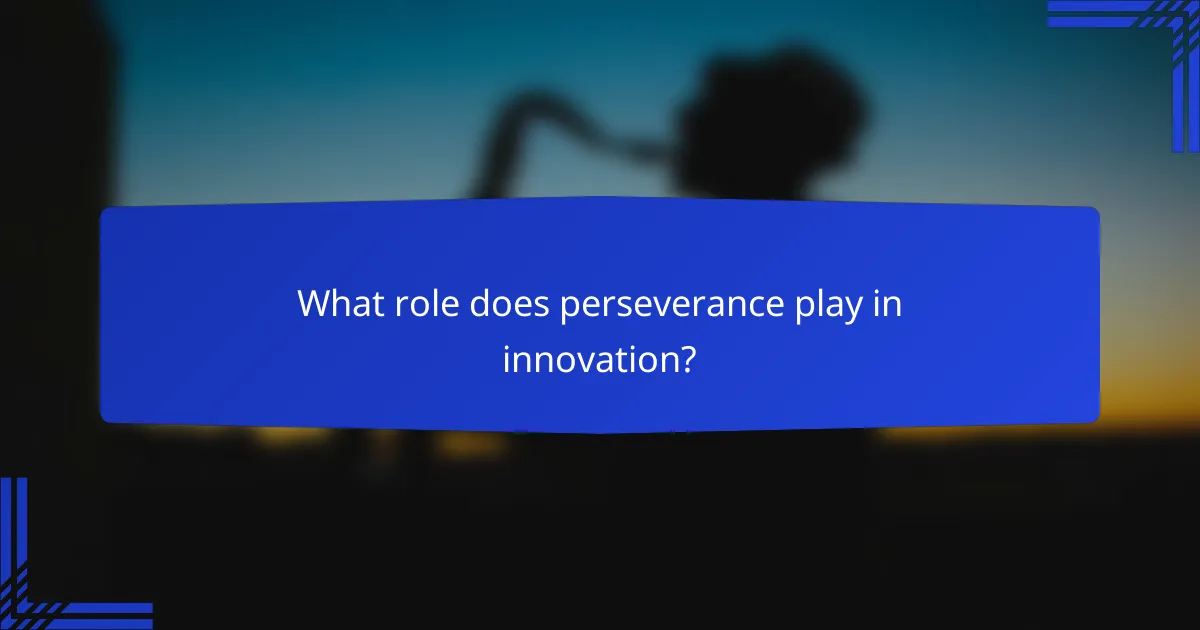Eccentric innovators often face significant market challenges, including limited funding, regulatory hurdles, and competition from established brands. To navigate these obstacles, they must explore diverse financing options and build strategic alliances. Ultimately, perseverance becomes essential, as it empowers these innovators to push through setbacks and transform their unique ideas into reality.

What market challenges do eccentric innovators face in Canada?
Eccentric innovators in Canada encounter several market challenges that can hinder their success. These include limited access to funding, regulatory obstacles, difficulties in gaining market acceptance, competition from established brands, and resource constraints.
Limited access to venture capital
In Canada, eccentric innovators often struggle to secure venture capital due to a conservative investment culture. Many investors prefer to back established businesses with proven track records rather than taking risks on unconventional ideas.
Innovators can improve their chances by building a strong business case, showcasing potential market demand, and demonstrating a clear path to profitability. Networking with angel investors and participating in pitch competitions can also help attract funding.
Regulatory hurdles
Regulatory hurdles can significantly impact eccentric innovators, especially in industries like technology and healthcare. Navigating complex regulations can be time-consuming and may require legal expertise, which adds to costs.
To mitigate these challenges, innovators should familiarize themselves with relevant regulations early in the development process. Engaging with regulatory bodies and seeking guidance from industry associations can provide valuable insights and streamline compliance efforts.
Market acceptance issues
Gaining market acceptance is often a major hurdle for eccentric innovators, as consumers may be hesitant to embrace unconventional products or services. This skepticism can stem from a lack of understanding or perceived risks associated with new ideas.
To enhance market acceptance, innovators should focus on effective marketing strategies that educate potential customers about the benefits of their offerings. Building a community around the product and leveraging social proof through testimonials can also help in gaining trust.
Competition from established brands
Eccentric innovators frequently face stiff competition from established brands that have significant market share and resources. These brands often have loyal customer bases and well-established distribution channels, making it challenging for newcomers to penetrate the market.
Innovators can differentiate themselves by emphasizing unique features, targeting niche markets, or offering superior customer service. Collaborations or partnerships with other businesses can also provide a competitive edge.
Resource constraints
Resource constraints, including limited financial, human, and technological resources, are common challenges for eccentric innovators. These limitations can hinder product development, marketing efforts, and overall business growth.
To address resource constraints, innovators should prioritize their initiatives and focus on the most impactful activities. Utilizing lean startup methodologies and seeking partnerships or grants can also help maximize available resources and drive progress.

How can eccentric innovators overcome funding issues?
Eccentric innovators can overcome funding issues by exploring diverse financing options, leveraging community support, and forming strategic alliances. By tapping into various funding sources, they can secure the necessary capital to bring their unique ideas to life.
Crowdfunding platforms like Kickstarter
Crowdfunding platforms such as Kickstarter allow innovators to present their projects to the public and raise funds directly from interested backers. This method not only provides financial support but also helps gauge market interest and build a community around the project.
To succeed on these platforms, innovators should create compelling presentations that clearly outline their vision, funding goals, and rewards for backers. Engaging video content and detailed project descriptions can significantly enhance appeal.
Angel investors in Toronto
Angel investors in Toronto are individuals who provide capital for startups in exchange for equity or convertible debt. These investors often seek innovative ideas and are willing to take risks on unconventional projects, making them a valuable resource for eccentric innovators.
Networking events, pitch competitions, and startup incubators in Toronto can help innovators connect with potential angel investors. It’s crucial to present a solid business plan and demonstrate how the innovation addresses a specific market need.
Government grants for innovation
Government grants for innovation provide non-repayable funds to support research and development projects. These grants can be an excellent option for eccentric innovators, as they often focus on fostering creativity and technological advancement.
In Canada, programs like the Industrial Research Assistance Program (IRAP) offer financial assistance to small and medium-sized enterprises. Innovators should research eligibility criteria and application processes to maximize their chances of securing funding.
Strategic partnerships with local businesses
Forming strategic partnerships with local businesses can provide eccentric innovators with additional resources, expertise, and market access. Collaborations can lead to shared funding opportunities and enhance the credibility of the project.
Innovators should identify businesses that align with their vision and propose mutually beneficial partnerships. This could involve co-developing products, sharing marketing efforts, or leveraging each other’s networks to reach a wider audience.

What role does perseverance play in innovation?
Perseverance is crucial in innovation as it drives individuals to overcome challenges and setbacks. Innovators often face numerous obstacles, and their ability to persist can determine the success or failure of their ideas.
Case studies of successful innovators
Many successful innovators exemplify the power of perseverance. For instance, Thomas Edison famously failed thousands of times before inventing the light bulb. Similarly, J.K. Rowling faced numerous rejections before “Harry Potter” became a global phenomenon.
These examples highlight that perseverance often leads to breakthroughs, as continued effort can refine ideas and improve solutions. Innovators should learn from these cases to embrace failure as a stepping stone rather than a setback.
Importance of resilience in entrepreneurship
Resilience is a key trait for entrepreneurs, enabling them to bounce back from failures and adapt to changing market conditions. Entrepreneurs often encounter funding issues, market challenges, and competition, making resilience essential for long-term success.
Building resilience involves developing a positive mindset, learning from mistakes, and maintaining focus on goals. Entrepreneurs should practice self-care and seek feedback to strengthen their resolve and enhance their adaptability.
Building a supportive network
A supportive network can significantly bolster an innovator’s perseverance. Connecting with mentors, peers, and industry professionals provides encouragement and valuable insights, helping to navigate challenges more effectively.
To build a strong network, attend industry events, join relevant online forums, and engage in local entrepreneurial communities. Actively nurturing these relationships can create a safety net during tough times, fostering collaboration and shared learning.

What frameworks can help assess innovation success?
Frameworks for assessing innovation success provide structured approaches to evaluate the viability and potential impact of new ideas. These tools help innovators identify strengths, weaknesses, and market readiness, guiding them toward effective strategies for development and funding.
Innovation maturity models
Innovation maturity models help organizations gauge their current innovation capabilities and identify areas for improvement. These models typically categorize innovation processes into stages, such as ideation, development, and commercialization, allowing companies to benchmark their progress against industry standards.
For example, a company may use a five-stage maturity model to assess its innovation process, ranging from initial idea generation to fully integrated innovation strategies. This structured approach can highlight gaps in resources or skills and inform targeted investments in training or technology.
Market readiness assessments
Market readiness assessments evaluate how prepared an innovation is for launch in the marketplace. This process involves analyzing factors such as customer demand, competitive landscape, and regulatory requirements to determine if the product or service is viable.
To conduct a market readiness assessment, innovators should gather data on potential customers, test prototypes, and analyze market trends. A checklist can help ensure all critical aspects are covered, such as pricing strategies, distribution channels, and marketing plans. For instance, assessing customer feedback during pilot testing can provide valuable insights into necessary adjustments before a full launch.

What are the emerging trends for eccentric innovators in Canada?
Eccentric innovators in Canada are increasingly embracing unique approaches to address market challenges, funding issues, and the need for perseverance. Key trends include a heightened focus on sustainability, the integration of technology, and the importance of community engagement.
Increased focus on sustainability
The trend towards sustainability is reshaping how eccentric innovators operate in Canada. Many are prioritizing eco-friendly practices and products, which not only appeal to environmentally conscious consumers but also align with government regulations aimed at reducing carbon footprints.
Innovators are exploring various sustainable business models, such as circular economies, where products are designed for reuse and recycling. For example, a startup might create biodegradable packaging solutions that minimize waste while offering a competitive edge in the market.
To effectively implement sustainable practices, innovators should consider the following tips: assess the environmental impact of their products, seek partnerships with green suppliers, and stay informed about sustainability certifications that can enhance credibility. Avoid common pitfalls like greenwashing, which can damage reputation and consumer trust.
